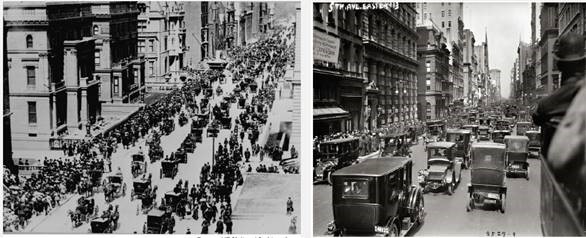At the turn of the 20th century cities were dirty places to live. Coal was the primary fuel for industry and heating, while horses and wagon were the primary means of transport. This mean that industrial cities had very polluted air and streets. Citizens suffered under all this pollution and desired change. When the automobiles promised to solve cities horse manure problems, the transition went very quickly. In 13 years 5th avenue in New York went from no cars to no horses. Can you can see on the picture below. Change can go very fast if society wants it.

When the car first became popular people had no idea of the negative effects it would have on health outcomes. The consequences of particulate matter (PM) were unknown. And as opposed to horse manure, exhaust emissions were invisible. One hundred years later we now know better. The World Health Organization has calculated that there are more people dying from toxic air, from car exhaust and pollution than from car accidents. That is more than 1 million deaths per year.
PM is so harmful because they are so small that they can be inhaled. The tiniest of these named PM10 pose the greatest problems as they get deep into the lungs and blood stream. Which leads to heart and breathing problems. Heart disease being the leading cause of death worldwide. And the number of people with breathing problems such as asthma is increasing. Other negative effects of PM are reduced visibility such as smog, depleted nutrient balance in soils and ground water, as well as acid rain.
Particulate matter can come from many sources. These are classified into primary and secondary sources. Primary sources include the burning of fuel for transport, industrial, commercial or domestic purposes. Abrasion of tires and brake pads. Or natural sources such as sea spray or desert dust. The destruction of buildings also produces a lot of PM. Secondary PM sources are chemical compounds that react with the air in the atmosphere to become PM. These are pollutants such as sulphur dioxides (SOx), nitrogen dioxides (NOx), volatile organic compounds (VOCs), and ammonia.
The problem with emission is that for the most part they are invisible. Nowadays we can measure them on a street level. Particulate matter measuring stations have sprouted up everywhere unnoticed. And “if you can measure, it you can fix it.” Some regulators have set legal limits for pollutants, and if pollutants exceed certain levels roads can be closed to non-zero emission vehicles. Similar to a speeding ticket, a car that are exceeds emission limits will have to pay a penalty. Pollution is a killer argument for change in cities today as it was one century ago.


